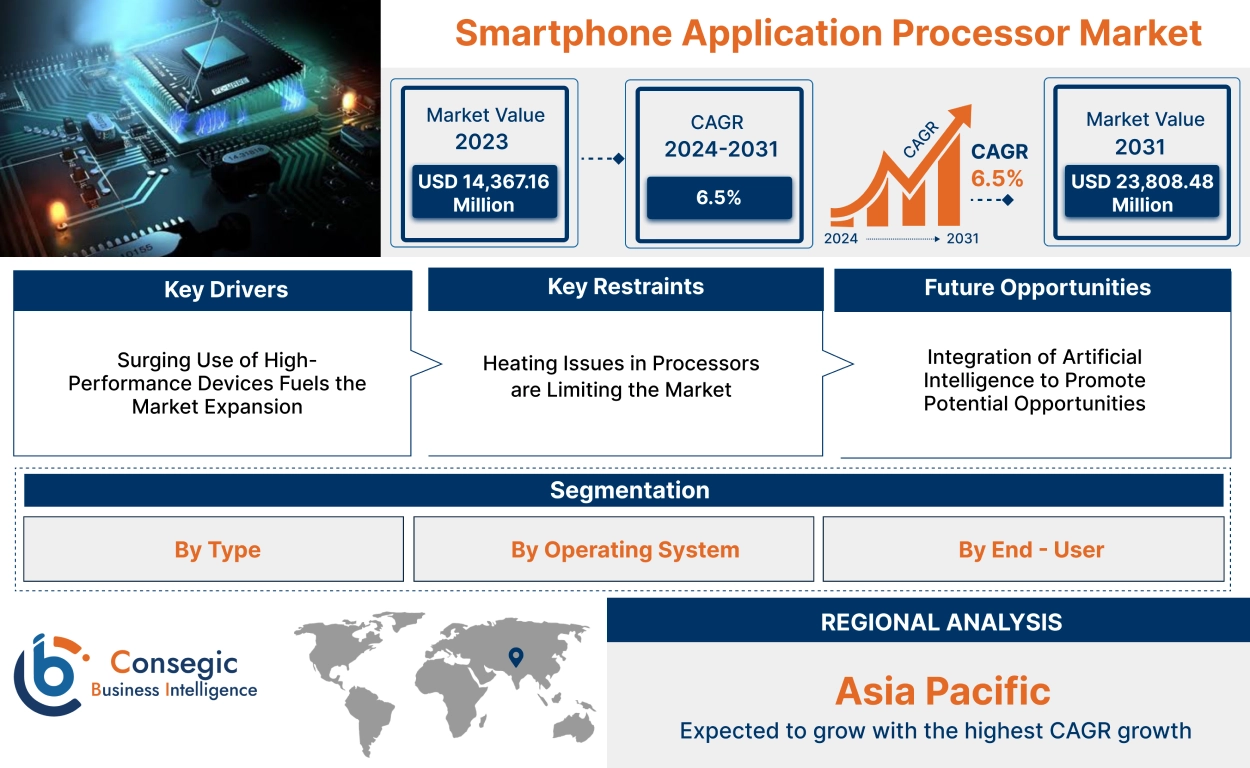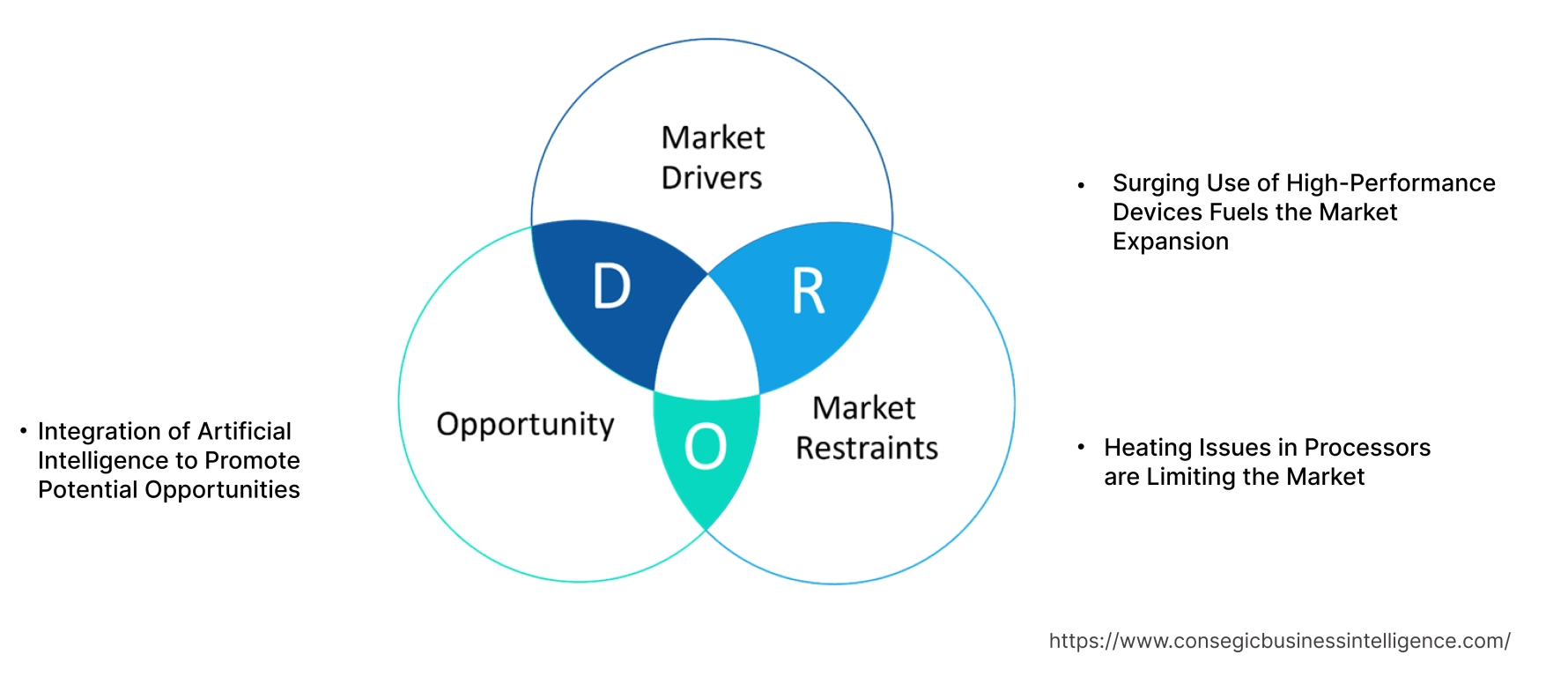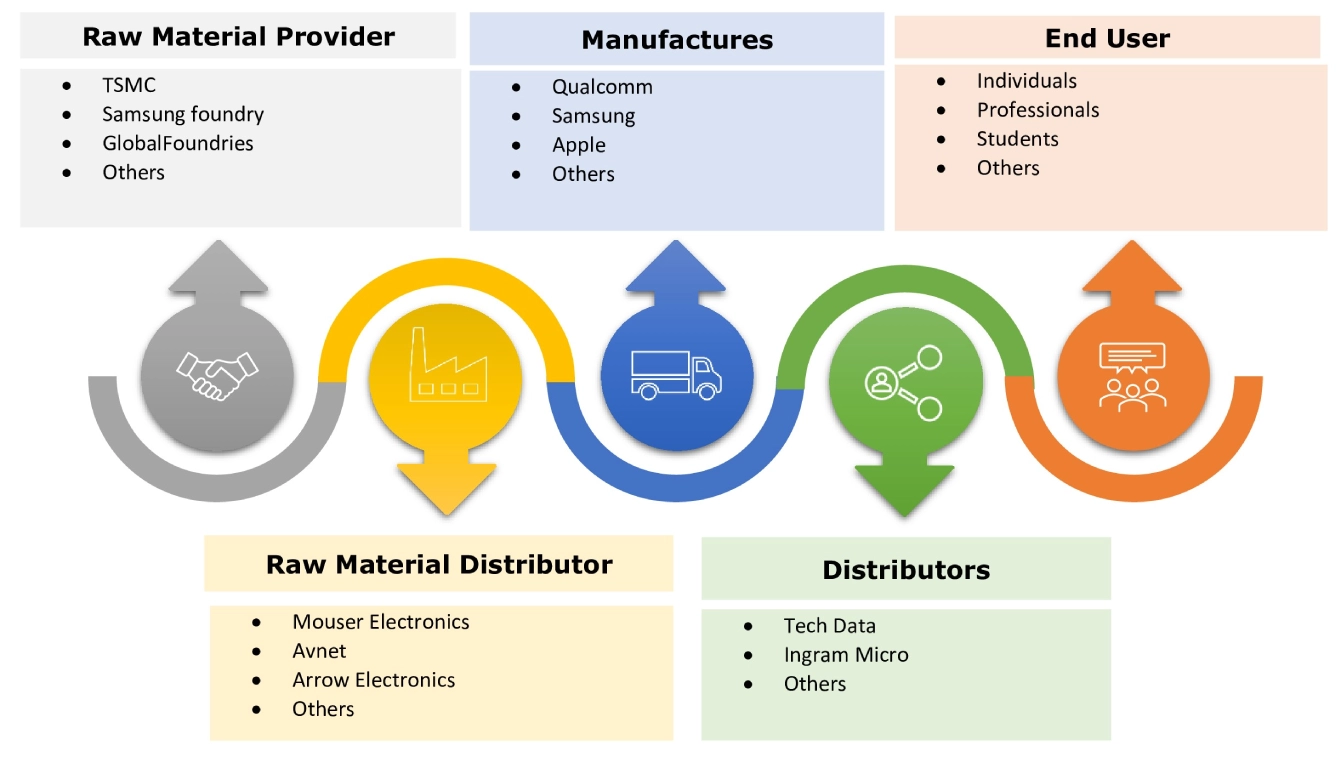- Summary
- Table Of Content
- Methodology
Smartphone Application Processor Market Size:
Smartphone Application Processor Market is estimated to reach over USD 23,808.48 Million by 2031 from a value of USD 14,367.16 Million in 2023 growing at a CAGR of 6.5% from 2024 to 2031.
Smartphone Application Processor Market Scope & Overview:
The smartphone application processor is a specialized system on a chip (SoC) designed to handle the primary computational functions of a smartphone. It serves as the central hub for a smartphone, managing tasks like app execution, video playback, and gaming. It incorporates essential components, including the CPU for basic functions and the GPU for image and video processing. Moreover, it provides various advantages including improved performance, better graphics, power efficiency, and enhanced user experience. The aforementioned benefits are primary determinants for increasing their deployment in businesses, healthcare, education, entertainment, and other industries, driving the expansion of the smartphone application processor market.
Smartphone Application Processor Market Insights:
Key Drivers:
Surging Use of High-Performance Devices Fuels the Market Expansion
High-performance processors enable smartphones to support a wide range of advanced features including high-resolution, displays, complex gaming graphics, and AI-driven applications. The demand for high-performance processors is driven by consumers seeking enhanced functionalities for browsing websites, improved communication, banking, and playing games on smartphone devices. Additionally, it provides the processing power needed to run apps smoothly and quickly. It also enhances visual experiences with high-quality graphics for games, videos, and user interfaces.
- According to an analysis by Deloitte, smartphone use is ingrained in the daily lives of consumers. A total of 96% of participants reported owning a smartphone, an increase from the previous year's 94%. Smartphones are the preferred choice for browsing shopping websites, conducting online purchases, searching the internet, handling banking tasks, and playing games.
Therefore, the increasing growth of high-performance devices enabling smooth operations and enhanced functionalities is driving the smartphone application processor market growth.
Key Restraints :
Heating Issues in Processors are Limiting the Market
Overheating issues lead to thermal throttling, where processors reduce speed to prevent damage, resulting in reduced performance, particularly in high-demand applications such as gaming, browsing, editing, and others. This hampers user experience, increases power consumption, reduces battery life, and causes faster wear on components. Additionally, a bug in the operating system leads to excessive device heating, negatively impacting performance, causing the processor to overwork, generating more heat, and triggering thermal throttling, which reduces processing speeds.
- In October 2023, Apple attributed a glitch in its operating system to a bug when updating iOS 17 on phones, as reported by the BBC News article. iPhone users anticipate their devices heating up during the initial setup or when backing up, given the high processing power being utilized and the handset working extra hard.
Hence, as per the analysis, users' lag experience, slower app performance, and decreased battery life due to the heating of the device are impeding the smartphone application processor market.
Future Opportunities :
Integration of Artificial Intelligence to Promote Potential Opportunities
AI-powered features including voice assistants, predictive text input, and smart camera capabilities improve user interaction and satisfaction. Application processors with dedicated AI accelerators can efficiently handle these AI tasks, enhancing overall device performance. Additionally, AI enables smartphones to personalize user experiences based on individual preferences, usage patterns, and contextual information. AI can optimize battery usage, recommend content, and anticipate user needs, all of which require robust processing capabilities.
- In June 2024, Apple introduced Apple Intelligence, the personal intelligence system for iPhone, iPad, and Mac, with an iOS system processor that utilizes generative models and personal context to deliver highly practical and pertinent intelligence.
Thus, the integration of Artificial Intelligence represents a transformative expansion of the smartphone application processor market share.
Smartphone Application Processor Market Segmental Analysis :
By Type:
Based on type the market is segmented into dual-core processors, quad-core processors, hex-core processors, octa-core processors, deca-core, and others.
Trends in the panel type:
- There is a general trend towards increasing the number of cores in smartphone processors. Manufacturers are consistently pushing for higher core counts to enhance multitasking and performance.
- Quad-core processors often feature power management technologies that enable them to adjust performance based on the workload. This improves energy efficiency by optimizing power consumption, rather than constantly running at full speed.
The octa-core processors segment accounted for the largest revenue share in 2023.
- Octa-core processors have eight cores organized into two groups of four cores, with each core capable of performing tasks similar to a quad-core processor.
- It offers a balanced combination of performance and efficiency, making it suitable for a worldwide range of smartphones from mid-range to flagship models.
- In January 2022, Samsung Electronics launched the Exynos 2200, the smartphone processor featuring a powerful AMD RDNA 2 architecture-based Samsung Xclipse graphics processing unit (GPU) and octa-core CPU for enhanced performance.
- Hence, the market analysis concludes that the trend for balanced performance and efficiency of octa-core processors is boosting the global smartphone application processor market trend.
The Deca-core processor segment is anticipated to register significant CAGR growth during the forecast period.
- The Deca-core processor incorporating ten Central Processing Unit (CPU) cores can run multiple applications offering superior multitasking performance and smooth operations.
- These processors with a high core count provide the necessary computational power to handle complex graphics, higher frame rates, and 4K video playback.
- Additionally, these processes allow for more cores to be packed into a single chip while maintaining power efficiency and thermal management.
- In May 2024, Apple introduced the M4 chip, offering remarkable performance with advanced 3-nanometer technology. The chip boosts the power efficiency of Apple silicon and enables the sleek design of the iPad Pro. The most recent CPU has a maximum of 10 cores, while the 10-core GPU is built on M3's next-generation GPU architecture, introducing dynamic caching, hardware-accelerated ray tracing, and hardware-accelerated mesh shading to iPad.
- Thus, the growing trend for superior multitasking and smooth operations is anticipated to propel the global smartphone application processor market opportunities.
By Operating System :
Based on the operating system, the market is segmented into iOS, Android, and others.
Trends in the operating system:
- Custom OS platforms often used in niche markets, emphasize security and privacy. These smartphone devices prioritize secure communication and data protection catering to personalized demand.
- iOS provides timely and consistent software updates across its devices, for seamless and lag-free usage of the smartphone.
The Android segment accounted for the largest revenue share of 57.88% in 2023.
- Android is the most widely used mobile operating system globally, with a substantial user base.
- Factors including app and service ecosystems available through the Google Play Store and Google Cloud for data storage, as well as support and enhance the functionality of Android devices.
- Additionally, the processors integrated with Android systems offer smooth multitasking, enhanced connectivity, and reduced latency.
- For instance, Qualcomm Technologies' Snapdragon Seamless, a cross-platform technology that facilitates a smooth multi-device experience on Android operating systems. It includes a wide range of tools and services, connects devices, and enables information sharing through advanced low-power, low-latency technologies.
- Therefore, as per the analysis, the need for apps and services incorporated with Android is boosting the smartphone application processor market growth.
The iOS segment is expected to witness significant CAGR growth during the forecast period.
- iOS is known for seamless integration with Apple products and services, including iPhones, iPads, Macs, Apple Watch, and Apple TV, providing enhanced user experience.
- Features including secure enclave, Face ID, and regular security updates ensure secure user information and communication offering personalization.
- In September 2022, Apple released iOS 16 with new features and enhancements including a customizable lock screen designed to use Touch ID or Face ID for biometric verification, improved focus mode, and advanced privacy protection.
- Hence, the demand for enhanced security and protection is driving the smartphone application processor market opportunities in the forecast period.
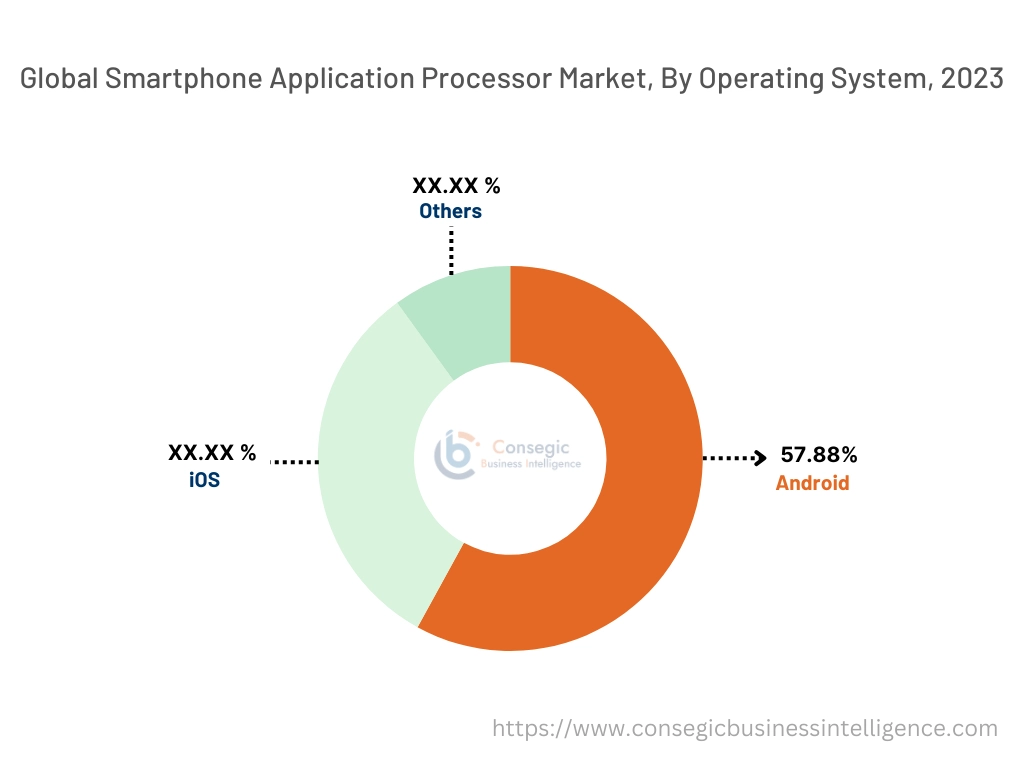
By End User:
Based on end-user the market is segmented into Individuals, Professionals, Gamers, Students, Photographers, and Others.
Trends in the End User:
- Enhanced security features, including biometric authentication and encrypted storage are increasingly being used by professionals who handle sensitive data and require robust protection.
- Increasing support for educational apps and e-learning platforms, with processors optimized to handle interactive learning, video lectures, and collaborative tools efficiently.
The individual segment accounted for the largest revenue share in 2023.
- The general individual segment includes the largest number of consumers globally.
- Smartphones are essential for everyday activities including communication, social media, web browsing, and basic multimedia consumption, making them indispensable for most individuals.
- Additionally, the processors offering enhanced security, data protection, and personalization are boosting the trend.
- In June 2023, Apple announced iOS 17 improving the personalized and user-friendly aspects of the iPhone. The update enhances communication with Phone, FaceTime, and Messages, streamlines sharing via AirDrop, and enhances typing with smarter input for speed and accuracy.
- Therefore, the analysis concludes that individuals seek enhanced personalization and security, propelling the smartphone application processor market share.
The gamer segment is anticipated to register the fastest CAGR growth during the forecast period.
- The rapid growth of mobile gaming is driving the entertainment industry, with the convenience and accessibility of gaming on smartphones leading the way.
- Features including high-refresh-rate displays, improved audio, and haptic interface in devices are targeting the gamers segment.
- Additionally, the processor supporting gaming apps in smartphones enhances the user experience by making it more interactive.
- In May 2023, the ONE Esports mobile app supported by Samsung was released solely for Samsung Galaxy smartphones, offering Samsung Galaxy users first access to the latest esports news, enhancing the gaming experience.
- Thus, the trend for gaming apps for smartphones is expected to boost the smartphone application processor market demand
Regional Analysis:
The regional segment includes North America, Europe, Asia Pacific, the Middle East and Africa, and Latin America.
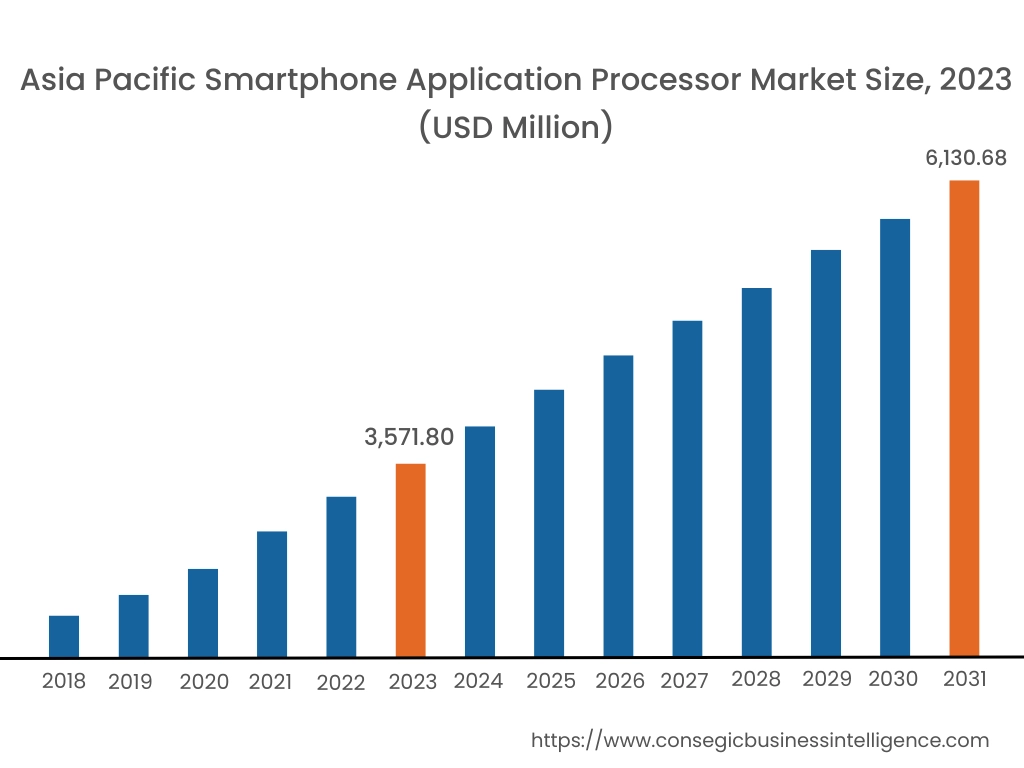
Asia-Pacific region was valued at USD 3,571.80 Million in 2023. Moreover, it is projected to grow by USD 3,752.11 Million in 2024 and reach over USD 6,130.68 Million by 2031. Out of this, China accounted for the maximum revenue share of 36.1%.
Asia Pacific has the fastest-growing smartphone application processor market, fueled by a high population and increasing smartphone penetration in countries including, China, India, and Southeast Asia. Moreover, the rapid adoption of new technologies, including 5G, AI integration, and advanced gaming features, boosts the need for high-performance processors.
- In January 2021, Samsung Electronics Co. Ltd. (South Korea) introduced 5G advancement with the recent launch of the company's vRAN 2.0 solutions, offering fully virtualized commercial 5G RAN from a single vendor. This will assist in developing programmable networks that can dynamically and effectively deliver the necessary network resources to customers using various advanced wireless services and applications.
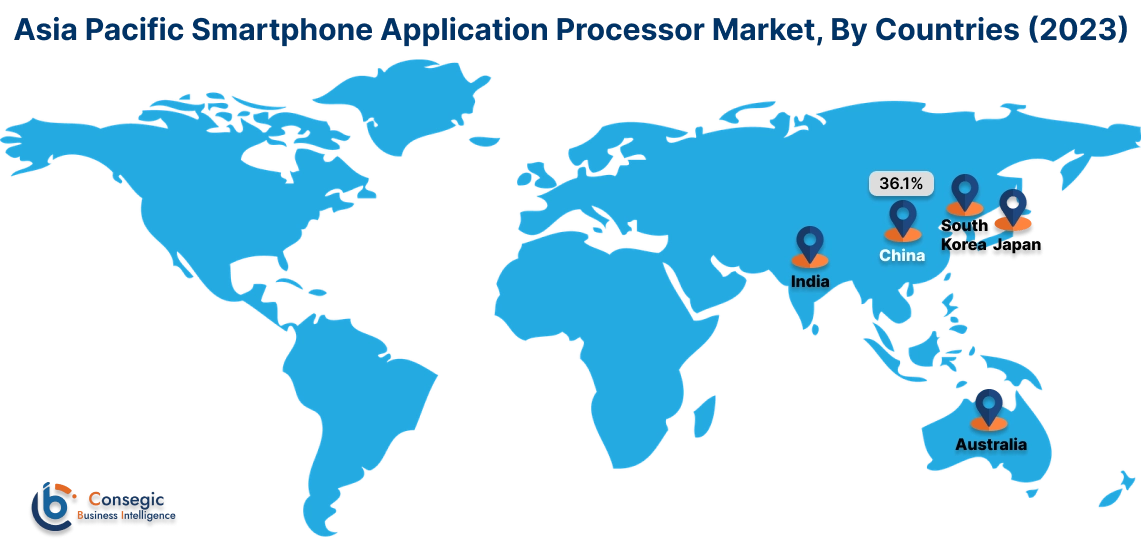
North America is estimated to reach over USD 8,085.36 Million by 2031 from a value of USD 4,877.77 Million in 2023 and is projected to grow by USD 5,108.90 Million in 2024.
North America remains a significant market due to the increasing need for premium smartphones. The region sees continuous expansion driven by technological advancement and consumer preferences for high-performance devices. Additionally, the presence of major tech companies and strong R&D capabilities contribute to the development of advanced processors.
- In January 2022, Intel (US) unveiled the 12th Gen Intel Core H-series mobile processor, with Up to 5 GHz frequencies, 14 cores (6 P-cores and 8 E-cores), and 20 threads, delivering the fastest and most high-performance processor.
Europe is experiencing consistent growth driven by the increasing need for high-performance smartphones in countries including the UK, Germany, and France. Consumers prefer devices with robust performance and security features sustainable and energy-efficient processors proliferating the smartphone application processor market demand.
As per the smartphone application processor market analysis, the Latin American market is expanding, with growing consumer adoption of smartphones, the main markets being Brazil, Argentina, and Mexico. Consumer interest in high-end smartphones is increasing, leading to a higher demand for improved processors.
In the Middle East and Africa, the market is poised to grow with the increase in digitalization and smartphone penetration among consumers. The adoption of 5G and enhanced security is propelling the expansion of smartphone application processors.
Top Key Players & Market Share Insights:
The smartphone application processor market is highly competitive with major players providing high-performance devices to the national and international markets. Key players are adopting several strategies in research and development (R&D), product innovation, and end-user launches to hold a strong position in the smartphone application processor industry. Key players in the smartphone application processor industry include-
- MediaTek Inc. (Taiwan)
- Samsung Electronics (South Korea)
- Qualcomm Technologies, Inc (US)
- Intel Corporation (US)
- Lenovo Group Ltd (Hong Kong)
- Apple Inc. (US)
- HTC Corporation (Taiwan)
- Nvidia Corporation (US)
- Huawei Technologies Co (China)
- Analog Devices, Inc (US)
Recent Industry Developments :
Product Launches
- In January 2024, ASUS Republic of Gamers (ROG) launched the ROG Phone 8 series with a SnapDragon processor featuring AI-powered performance, ultra-bright display, and AniMe Vision.
- In September 2023, Apple unveiled the iPhone 15 and iPhone 15 Plus with iOS system processors highlighting advanced camera system, display, super high-resolution, enhanced security, and customization.
- In April 2023, Vivo launched the T2 5G series with an Android processor, AMOLED display, and a 64MP OIS Anti-Shake camera. It also includes enhanced personalization choices, updated privacy and security elements, and fresh control features for a seamless, continuous user experience.
Collaboration
- In February 2024, Micron Technology, Inc. revealed that Samsung integrated Micron's LPDDR5X memory and UFS 4.0 mobile flash storage in certain devices from the Samsung Galaxy S24 series, powered by an Android system processor, bringing advanced AI capabilities to mobile users.
- In January 2024, Samsung and Google Cloud collaborated to introduce Gemini-powered AI on the Samsung Galaxy S24 Series using an Android processor system, efficiently handling various types of information such as text, code, images, and video.
Smartphone Application Processor Market Report Insights :
| Report Attributes | Report Details |
| Study Timeline | 2018-2031 |
| Market Size in 2031 | USD 23,808.48 Million |
| CAGR (2024-2031) | 6.5% |
| By Panel Type |
|
| By Operating System |
|
| By End Users |
|
| By Region |
|
| Key Players |
|
| North America | U.S. Canada Mexico |
| Europe | U.K. Germany France Spain Italy Russia Benelux Rest of Europe |
| APAC | China South Korea Japan India Australia ASEAN Rest of Asia-Pacific |
| Middle East and Africa | GCC Turkey South Africa Rest of MEA |
| LATAM | Brazil Argentina Chile Rest of LATAM |
| Report Coverage |
|
Key Questions Answered in the Report
What is the key market trend? +
There is a general trend towards increasing the number of cores in smartphone processors. Manufacturers are consistently pushing for higher core counts to enhance multitasking and performance.
How big is the Smartphone Application Processor market? +
Smartphone Application Processor Market is estimated to reach over USD 23,808.48 Million by 2031 from a value of USD 14,367.16 Million in 2023 growing at a CAGR of 6.5% from 2024 to 2031.
Who are the major players in the Smartphone Application Processor market? +
Key players in Smartphone Application Processor are MediaTek Inc (Taiwan), Samsung Electronics (South Korea), Apple Inc (US), Qualcomm Technologies, Inc (US), Intel Corporation (US), Lenovo Group Ltd (Hong Kong), HTC Corporation (Taiwan), Nvidia Corporation (US), Huawei Technologies Co (China) and others.
Which region/country is anticipated to witness the highest CAGR during the forecast period, 2024-2031? +
The Asia-Pacific region is anticipated to witness the highest CAGR of 7.0% during the forecast period, 2024-2031.
